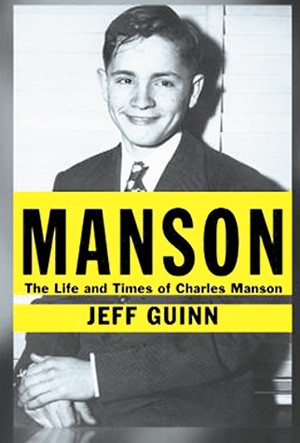The vintage black and white cover photo shows a clean cut young teen in a suit — it looks like the Easter Sunday picture seen on many a family mantel. Instead of church, though, he’s dressed for a court appearance. Everyone of a certain age knows about the horrific crimes of Charles Manson and his family. Few of us, however, understand anything about the man and how he became one of the most notorious people of his time. Readers of Jeff Guinn’s book, Manson: The Life and Times of Charles Manson will come as close to understanding as anyone can.
How did Charles Manson become the person he was? Was it nature or nurture? What effects did the social upheavals during his lifetime have upon him? Was he a product of his times? Guinn attempts to answer these questions. To do so, he delves deeply into the life of Manson and a history of the times. His extensive research included interviews with Manson’s sister and cousin — both of whom had never agreed to be interviewed before.
Guinn tells the story of a boy who was born to a fifteen-year-old who was not yet ready to be a mother. He lost the man he knew as his father as a toddler. Then his mother participated in a robbery resulting in her incarceration. He lived with relatives during her incarceration. There he showed a real interest in music and weapons. He started school with a teacher who terrorized all the students. He developed the skill of deflecting blame early in life. After his mother left jail and remarried, he moved to Indianapolis. There he started getting into trouble in the neighborhood and with the law. His mother sent him to the Gibault School for Boys. Later he was incarcerated in the Pendleton Reformatory. Not an auspicious start to life. He did, however, have a grandmother who loved him dearly. When he was incarcerated in California, his mother moved to be close to him. So not all was terrible.
The next big question is how Manson attracted and kept loyal his devoted group of followers or “family.” Guinn discusses this at length. Manson was of high average intelligence who could be incredibly charming when he so desired. He took many courses while incarcerated including Dale Carnegie’s course in how to win friends and influence people. He also developed a philosophy based on elements of Beatles lyrics, Robert Heinlein’s novel Stranger in a Strange Land, Christianity, and societal concerns of a looming race war. Using brainwashing type techniques, he convinced his family to believe adherence to him and his demands was their only chance of survival.
Guinn skillfully weaves the information on Manson into stories of the times. Particularly interesting to me was the description of the life cycle of the flower children and their culture in Haight-Ashbury. In an objective manner, Guinn describes the early flower children and their peaceful ideals and goals. Quickly, though, human nature took over and their utopia was transformed into a drug addled culture with many disillusioned young people looking for fulfillment and meaning.
This is not a sensationalist book. Although it describes the murders, it does so in a matter of fact police officer manner. It also does not tell every aspect of the trials. This book emphasizes the unusual confluence of elements that produced Charles Manson and transformed him from an innocent baby into one of the most notorious criminals in the history of the United States.



